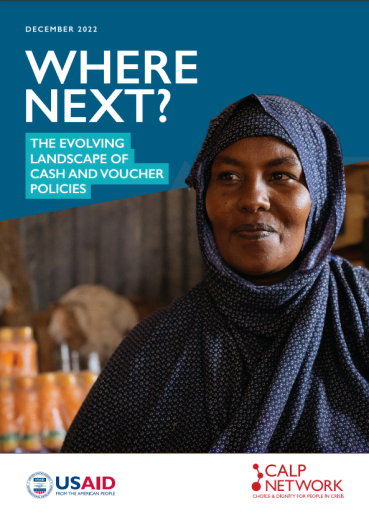Where Next? The Evolving Landscape of Cash and Voucher Policies
What’s in the report
The use of Cash and Voucher Assistance is considered one of the 2016 Grand Bargain’s most successful achievements. CVA now accounts for approximately 19% of international humanitarian assistance, and has – according to the sister study for this report and a previous study undertaken by GPPi – the potential to increase significantly more. This report explores how early policy commitments impacted the evolution of CVA and distils what the CVA policy landscape looks like now.
The research found that:
- The CVA policy environment has evolved hugely since 2016 with enormous progress in many areas. Collective commitments have provided a foundation for progress, with external commitments, internal motivation and environmental factors all playing a part in accelerating change.
- The use of CVA has expanded and there is now a much greater understanding of how it can be used effectively, including a heightened focus on linkages between humanitarian cash and social assistance. Cash assistance is no longer questioned as a modality. It has become both a norm and a key operational standard in humanitarian practice.
- While every interviewee considered their agency to be committed to CVA, there were differing views of what constitutes a CVA-related policy commitment and how different types of commitments influenced agencies. These insights cast a light on the complex web of policies that influence, to varying extents, change at individual and system-wide level.
- Drivers of change were identified as being policy commitments, CVA being embedded into internal strategies, coordinated efforts to grow CVA, agencies satisfied with outcomes of CVA programmes, growth in the number of financial service providers (FSPs), more acceptance of risk, donor pressure, and robust evidence around the efficacy of CVA.
- Stumbling blocks were seen as being the approaching conclusion of the Grand Bargain, deeply entrenched systemic issues, data interoperability and management, limited localization, and a loss of focus.
- Some people felt that certain CVA-policy issues are now ‘settled’, with change embedded to an extent that a positive trajectory is likely to continue. This was seen as being true for the commitment to increase the volume of CVA, the routine consideration of CVA and building internal capacity, as well as strengthening partner capacity to use CVA.
- Even though strong progress has been made in some areas, overwhelmingly, key informants felt there was need to maintain the focus, effort, and attention on existing policy areas, pushing further and nuancing topics in the process. There was concern about the implications of the pending potential conclusion of the Grand Bargain. There was a recognition that ongoing attention to localisation was essential as well as coordination, interoperability and data management. Each of these areas was seen as needing much larger change but progress was being hampered by deeply entrenched systemic issues. There was also broad agreement about the need for dialogue on ‘CVA and Climate’.
Methodology
Interviews were undertaken with staff from 28 organisations, including from 7 donors, 4 UN agencies, 10 INGOs, 2 national NGOs, 1 national government, IFRC and ICRC. Multiple policy documents were also reviewed.
Next steps
Whilst this report looked at the evolving landscape of CVA, a sister report Increasing the Use of Humanitarian Cash and Voucher Assistance: Opportunities, Barriers and Dilemmas examined the potential for further scaling CVA.
A third piece People-focused, effective aid: The urgent need to accelerate progress on cash and voucher assistance for people in crisis summarises the essence of the two reports and provides a compelling case for urgent change.
We would encourage those whose work involves supporting people in crisis to continue engaging in a dialogue about the future of CVA – and establish and/or renew CVA commitments so that we do not miss this opportunity to make a difference for people affected by crisis.
Please subscribe to CALP email updates in order to keep abreast of any developments or opportunities to engage.



